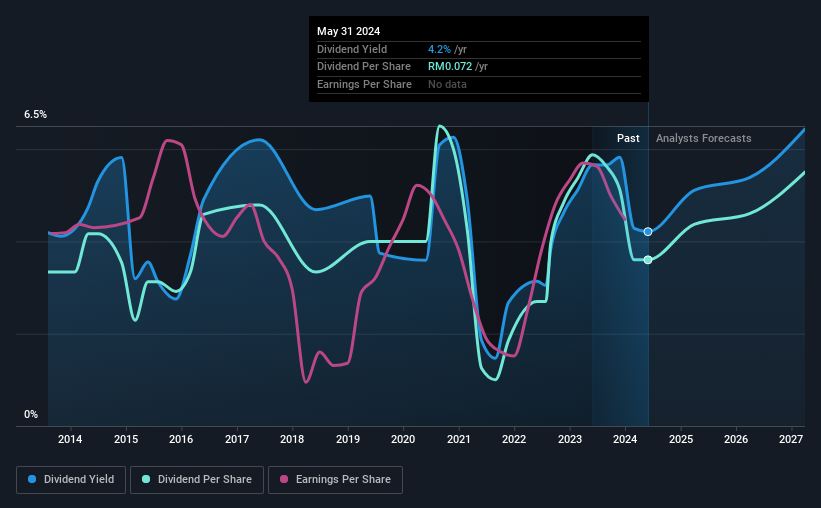Power Root Berhad (KLSE:PWROOT) Will Pay A Dividend Of MYR0.013
Power Root Berhad's (KLSE:PWROOT) investors are due to receive a payment of MYR0.013 per share on 5th of July. Despite the cut, the dividend yield of 4.2% will still be comparable to other companies in the industry.
See our latest analysis for Power Root Berhad
Power Root Berhad's Payment Has Solid Earnings Coverage
We like to see a healthy dividend yield, but that is only helpful to us if the payment can continue. The last dividend was quite comfortably covered by Power Root Berhad's earnings, but it was a bit tighter on the cash flow front. By paying out so much of its cash flows, this could indicate that the company has limited opportunities for investment and growth.
The next year is set to see EPS grow by 21.1%. If the dividend continues along recent trends, we estimate the payout ratio will be 54%, which is in the range that makes us comfortable with the sustainability of the dividend.

Dividend Volatility
While the company has been paying a dividend for a long time, it has cut the dividend at least once in the last 10 years. Since 2014, the annual payment back then was MYR0.0667, compared to the most recent full-year payment of MYR0.072. Dividend payments have grown at less than 1% a year over this period. The dividend has seen some fluctuations in the past, so even though the dividend was raised this year, we should remember that it has been cut in the past.
The Dividend Looks Likely To Grow
Growing earnings per share could be a mitigating factor when considering the past fluctuations in the dividend. It's encouraging to see that Power Root Berhad has been growing its earnings per share at 26% a year over the past five years. The company's earnings per share has grown rapidly in recent years, and it has a good balance between reinvesting and paying dividends to shareholders, so we think that Power Root Berhad could prove to be a strong dividend payer.
Our Thoughts On Power Root Berhad's Dividend
Overall, it's not great to see that the dividend has been cut, but this might be explained by the payments being a bit high previously. The low payout ratio is a redeeming feature, but generally we are not too happy with the payments Power Root Berhad has been making. Overall, we don't think this company has the makings of a good income stock.
It's important to note that companies having a consistent dividend policy will generate greater investor confidence than those having an erratic one. At the same time, there are other factors our readers should be conscious of before pouring capital into a stock. Taking the debate a bit further, we've identified 2 warning signs for Power Root Berhad that investors need to be conscious of moving forward. Looking for more high-yielding dividend ideas? Try our collection of strong dividend payers.
New: Manage All Your Stock Portfolios in One Place
We've created the ultimate portfolio companion for stock investors, and it's free.
• Connect an unlimited number of Portfolios and see your total in one currency
• Be alerted to new Warning Signs or Risks via email or mobile
• Track the Fair Value of your stocks
Have feedback on this article? Concerned about the content? Get in touch with us directly. Alternatively, email editorial-team (at) simplywallst.com.
This article by Simply Wall St is general in nature. We provide commentary based on historical data and analyst forecasts only using an unbiased methodology and our articles are not intended to be financial advice. It does not constitute a recommendation to buy or sell any stock, and does not take account of your objectives, or your financial situation. We aim to bring you long-term focused analysis driven by fundamental data. Note that our analysis may not factor in the latest price-sensitive company announcements or qualitative material. Simply Wall St has no position in any stocks mentioned.
About KLSE:PWROOT
Power Root Berhad
An investment holding company, manufactures and distributes beverage products in Malaysia, the Middle East, and internationally.
Excellent balance sheet and good value.
Market Insights
Weekly Picks

Solutions by stc: 34% Upside in Saudi's Digital Transformation Leader


The AI Infrastructure Giant Grows Into Its Valuation
Recently Updated Narratives
Many trends acting at the same time


Engineered for Stability. Positioned for Growth.


Staggered by dilution; positions for growth
Popular Narratives


MicroVision will explode future revenue by 380.37% with a vision towards success


NVDA: Expanding AI Demand Will Drive Major Data Center Investments Through 2026



